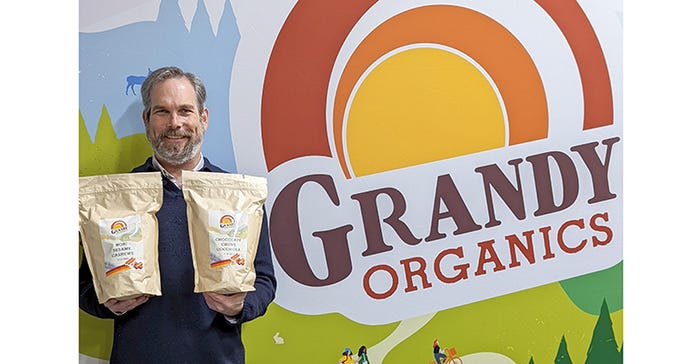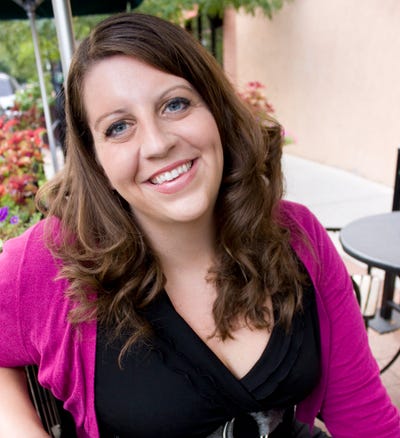Why Grandy Organics rebranded from Grandy OatsWhy Grandy Organics rebranded from Grandy Oats
With a new name and its familiar lifestyle feel, Grandy Organics is ready to expand its line.
March 8, 2022

Like many natural food business owners, Aaron Anker, the owner and co-founder of Grandy Organics—previously known as Grandy Oats—used the pandemic as a chance to regroup and consider the future.
The granola empire culled in rural Maine was seeing “really fast growth” over the last five years, Anker says.
For more than 40 years, Grandy Organics has created a classic “1970s era-style” granola brand that touts having 50% less sugar than its competitors. But COVID-19 and the related shutdowns threw a hard punch at food service and retailers' bulk sections.
“It was outside of our control,” says Anker, whose company saw more than 30% growth in 2019. “It was a down year for us, but we came back.”
After having one of its strongest first quarters ever in 2020, Anker says, the second quarter was one of its weakest, with Grandy Organics' sales dropping back to 2019 levels. The rollercoaster fluctuation prompted a lot of thought and discussion. Taking a “do no harm” mantra, the company rebranded under the guise of not trying to massively change the overall look or lifestyle feel while creating a platform that was more than “just oats” so it could usher in new products.
“We wanted to lean in. We’ve been certified organic for close to 20 years,” says Anker, aka the “chief granola officer.” “It’s a big differentiator for us and we wanted it in our name.”
Last month, Grandy Organics officially launched its rebranding, as co-founder and former co-owner Nat Pierce, the chief operations officer, exited the company and Anker took over as the sole owner.
The Hiram, Maine-based company produces approximately 2 million pounds of roasted nuts, trail mix and granola each year in a solar-powered, renovated 12,000-square-foot schoolhouse that offsets 145,000 pounds of greenhouse gas emissions annually.
Here’s what Anker has to say about the recent changes and future plans.

Why the recent change in ownership?
Aaron Anker: Nat [Peirce] and I had a really great partnership for over 20 years. It just got to the point Nat was ready to do something different. I wanted to lean in on the brand and grow it. This is an opportunity for me to do that. We’ve got a phenomenal team, but it gives me a chance to bring in some executive leadership to help grow the team.
What was the impetus behind the name change from Grandy Oats to Grandy Organics?
AA: We talked about it a few years ago, as we were launching our grain-free granola, Coconola, that’s made with lots of nuts and seeds and doesn’t have any oats in it.
When we launched, it took off and became the number one selling grain-free granola in the country. We took the “if it’s not broken, don’t fix it” philosophy, but it’s always lingered in the back of my mind.
Why now?
AA: The pandemic has given brands a chance to do some self-reflection. I’ve always felt like there was a bigger, wider template for us. We wanted to break outside of the granola category. I felt like it was something we needed to do.
How did you start the process?
AA: The brand’s been around since 1979 so it’s a big deal to change your name. About a year ago I challenged our graphic arts and digital agency [Portland-based Space Pilot] to start playing around with different logos. I didn't want to upset the consumers too much and liked our overall branding. They nailed it, because it’s not that big of a difference and the logo is still intact.
When did you start showcasing the new logo?
AA: We [soft] launched the brand out in the field. The new logo started showing up on our shelves in late November. Not one consumer has mentioned it to us.
A lot of times when you do a brand change, it’s to revitalize a brand or add some new energy. For us, it was “do no harm” and secondly it was to take the brand to another level with new products.
What does that mean products wise?
AA: We’re not divulging new products, but I can tell you it will be some new granolas and some stuff outside of the granola category. We aren’t going to turn away from our 40+ years of granola oat recipes.
With the new products, we will have to add on to our facility, look to add warehouse space onsite or elsewhere.
What is your current warehouse like?
AA: In 2016, we moved into an abandoned elementary school that sits on 8 acres with over 400 feet of riverfront on the Saco River. We put our building on the ball field where the kids used to play and put 288 solar panels in. We were one of the first food production facilities in the country to become solar powered. We still produce all of our products there.
What’s the long-term goal with compostable packaging?
AA: With more consumers buying food online, we launched our compostable packing on our website because it’s a more controlled environment. Our goal is to have compostable packaging on traditional store shelves in the future.
Right now, we’re conducting shelf-life studies. So far, the results are really good. We’re working with a company, a certified compostable producer in Canada. It’s about a 6-month time frame to compost the packaging in your backyard or commercially.
How much of your ingredients are Fair Trade?
AA: All of our Coconolas use Fair Trade ingredients. Anywhere to 25% to 40% of our ingredients are Fair Trade. In the past year, all of our cashews in the bulk sections and in our granolas are Fair Trade. It’s one of those items that are really important to be Fair Trade because there are a lot of bad practices for harvesting and selling cashews.
How are you managing supply chain and ingredients costs?
AA: Since we make all of our products, we’re in control of our situation. A lot of our suppliers have supplied us for more than 20 years and we’ve always paid them on time. We’re carrying a lot more inventory, like 50% more raw materials. Like honey, we now have 4 to 5 months on hand.
What advice do you have for other executives who want to rebrand?
AA: Grow slowly and smartly. We built a huge Gantt chart on all the things we had to do from business cards to sale sheets to all the digital online assets, to influencers and content. It was a long process, but at a certain point, you have to decide this is the right thing to do.
When is the right time to do an update?
AA: Talk to other brands who have gone through a change. It’s not a cheap endeavor. Think about when other changes need to make, for a nutritional panel update or any other update you might do on your branding or packaging.
About the Author
You May Also Like





